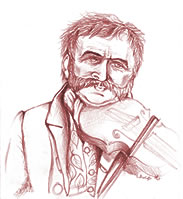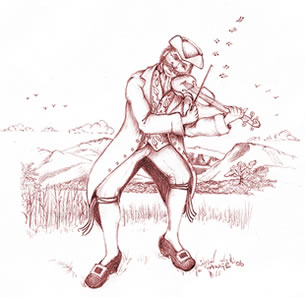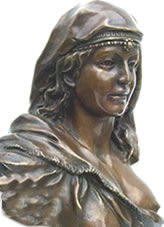A Davies, VStream©

Abram Wood
Around 1730 a notable figure in the history of Welsh Gypsies strolled into Wales from England. Abram and his family walked on foot, with their few possessions packed onto donkeys or mules.
During the day they worked on farms or made baskets from willow and pegs from elder. The evenings were for merriment beside a campfire or in the farmhouse; there was story-telling, singing and dancing, and lively music from the fiddle, which Abram was said to have introduced into Wales. At night they slept in bender tents made of skins stretched over hazel twigs.
Saiforella described her colourful great-grandfather, Abram Wood, thus: he was a tall thin man with rosy cheeks in a dark face. Atop he wore a three-cocked hat trimmed with gold lace, and gold rings adorned his fingers. His patterned waistcoat had buttons made of shillings and was pinned with a gold watch and chain. His silk coat had flying coat-tails and was buttoned with half-crowns. Ribbons tied his white breeches at the knee, and silver buckles shone on his feet.
Ribbons tied his white breeches at the knee, and silver buckles shone on his feet.
When Abram died in a cowshed on Cadair Idris he left behind him many descendants. The Woods had been the first tribe to make their home exclusively in Wales, and the teulu (family of) Abram Wood became known in Wales as the 'Welsh Gypsies'. Initially, they favoured Llanbrynmair near Machynlleth in Mid Wales but later on moved north. With the changing seasons, they returned to work the same farms each year and eventually swopped their tents for the farmers' barns. Some even began living in houses during the winter.
Valentine Wood and Jerry Bach
The Woods were Roman Catholic by religion and excellent fishermen, poachers, violinists and harpists by inclination. Valentine Wood, son of Abram, was the first to pick up the Welsh triple harp and although not very good himself he taught his sons to play. One son, Jerry Bach (small), was under 5 foot tall but for fifty years he played the 6 foot Welsh harp for the Pryse family of Plas Gogerddan, Aberystwyth. When Jerry died in 1867 a harp was etched on his gravestone.
John Wood Jones
John Wood Jones, great-grandson of Abram Wood, was also talented and he won the silver harp for best player at the Brecon Eisteddfod. He taught at a school for blind harpists, then became resident harpist at Llanover Court near Abergavenny, playing for the family and their guests after the evening meal. In 1843 he played at Buckingham Palace for Queen Victoria and Prince Albert.
Edward Wood
Stepbrother to John was Edward Wood, who lived at Bala and Ruthin. Like many Gypsies in Wales, he spoke Welsh, English and Romani. The Woods spoke a pure form of Romani undiluted by English, and Edward taught it to Dr John Sampson of Liverpool University. With his help, Sampson wrote a book entitled “The Dialect of the Gypsies of Wales, being the older form of British Romani preserved in the speech of the clan of Abram Wood". Like his stepbrother, Edward was a gifted harpist and had many folksongs at his fingertips. In fact, he still kept on playing even when slumped over the harp half-asleep, changing the tune when prodded and primed with beer. More soberly, he played for Queen Victoria in 1889 and for her son, the future King Edward VII. Edward married two sisters of the same Roberts family. With Mary Ann, herself a gifted harpist and singer, he had two children. She died in her twenties, and at some point he took up with her younger sister, Sarah. They had eight children together. Sarah had been superseded by a non-Romany woman by the time Edward died in 1902.
Matthew Wood
Another Wood who helped Dr Sampson with his research into Romani was Matthew, great-great grandson of Abram. Although not able to read or write, Matthew could speak beautifully and passionately, and he had a headful of tales related by Black Ellen, his grandmother. He was a terrific storyteller, enlivening his audience with dramatic reconstructions, and Sampson recorded and published his folktales. Matthew was a handsome fellow, with long black curls, velvet waistcoat and purple stockings. At various times, he lived near Abergwynolwyn, Corwen or Bala and was welcomed at their country inns, playing his fiddle to the dancing and singing of the villagers. All the same, he had an especial Gypsy-affinity with animals and moved so quietly around Wales that a pet name for him was 'Old Hedgehog'.
Harry 'Turpin' Wood
Matthew's eldest son, Harry, adopted his middle name from highwayman Dick Turpin, and he would ride around on a farm horse pretending it was Black Bess. Harry was illiterate but attractive, so he carried his favourite book about Turpin around with him and asked the women he met to read to him. In the 1930s he lived near Corwen and managed to send letters to a friend with the help of the local postmaster; the man didn't know Romani so guessed how to spell the words that Harry spoke out loud. At first the letters were about fly-fishing, ferrets in pockets and driving pheasants on the mountainside. By 1939, come World War II, Harry mentions wearing a gas mark and being afraid of the house falling down around him. In happier times Harry played the fiddle at local inns whilst brother Howel danced over brooms criss-crossed on the floor; father Matthew was ready to join in; and Reuben Roberts played on his harp.
Howel Wood
Another son of Matthew was Howel, who was a fiddler and clog-dancer. He appeared dancing on a table in the 1949 film The Last Days of Dolwyn, starring Emlyn Williams, Richard Burton and Edith Evans. He was an excellent fisherman and worked on Pantyneuadd Farm near Bala for forty years. All of Matthew's sons spoke Welsh Romani, and when Howel died in 1967 he may have been one of the last Gypsies to speak it fluently.
Strict Copyright Warning
All texts/audio/still/motion picture images are strictly copyright to ValleyStream Media 1980-2009 or to the stated contributor/
copyright holder/s or "unKn". Any unauthorised copying of any images or material from this website for any use is strictly prohibited without written permission from the image owners - owners of unknown images ("unKn") from this website please contact us for fair use or image withdrawal. All rights reserved.

